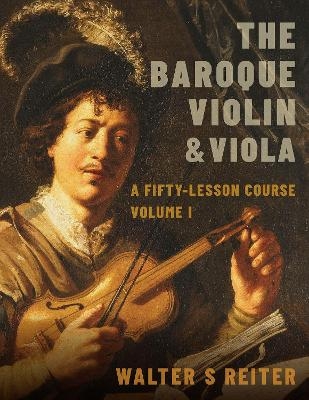
The Baroque Violin & Viola
Oxford University Press Inc (Verlag)
978-0-19-092270-2 (ISBN)
In the early seventeenth century, enthusiasm for the violin swept across Europe--this was an instrument capable of bewitching virtuosity, with the power to express emotions in a way only before achieved with the human voice. With this new guide to the Baroque violin, and its close cousin, the Baroque viola, distinguished performer and pedagogue Walter Reiter puts this power into the hands of today's players. Through fifty lessons based on the Reiter's own highly-renowned course at The Royal Conservatory of the Hague, The Baroque Violin & Viola, Volume I provides a comprehensive exploration of the period's rich and varied repertoire.
Volume I covers the basics of choosing a violin, techniques to produce an ideal sound, and sonatas by Vivaldi and Corelli. Practical exercises are integrated into each lesson, and accompanied by rich video demonstrations on the book's companion website. Brought to life by Reiter's deep insight into key repertoire based on a lifetime of playing and teaching, The Baroque Violin & Viola, Volume I: A Fifty-Lesson Course will enhance performances of professional and amateur musicians alike.
Walter Reiter is internationally recognized as a leading Baroque violinist, leader and conductor. He has made countless recordings with both British and European Baroque orchestras as well as several highly acclaimed solo CDs. A devoted and experienced teacher of both modern and Baroque violin, he is currently Professor of Baroque Violin and Viola in the Royal Conservatoire of The Hague in the Netherlands.
Foreword
Introductory quotes
Questions and Answers
Part One
The Basics
Lesson One. Prelude
Choosing a Violin - Choosing a Bow - Strings - Pitch.
Lesson Two. Holding the violin
How to hold the Baroque violin: a beginner's guide.
Lesson Three. The Bow, Creator of Sound
Holding the Bow.
Lesson Four. First Sounds: Celebrating our Vocal Heritage
Searching for our Vocal Roots - Exploring the Rhythm of words - Postscript.
Lesson Five. Copying the Human Voice: Sweelinck's Garrulous Little Swallow
Vowels - Dipthongs - Consonants - Double Consonants - Bowings - Postscript.
Lesson Six. Five Exercises to Help Accustom You to 'Chinless' Playing
Recalling These Exercises in a Performance Situation - Technical Factors - Emotional Factors - Nerves.
Lesson Seven. More Basic Concepts and Techniques. 'A Division on a Ground' by Mr Faronell, from 'The Division Violin,' London, 1684
The Importance of the Bass Line - Tempo and Rhythm - The Hierarchies and the Bow Impulses - Engramelle - Good Notes and Bad Notes - Varying the Articulation.
Lesson Eight. Learning to Feel. Developing a heightened awareness of the Emotional Power of Sound and the Intervals
Emotional Information: What Sound Tells Us - How to Prepare: Manipulating Our Emotions.
Lesson Nine. The Inner Life of Sound: 'Messa di voce'
Lesson Ten. Applying the Messa di voce. Arcangelo Corelli: Adagio from Sonata Opus V No 3
Applying the 'Messa di voce' - Dissonances and Consonances - On Trills - In Praise of the Second Position - Hemiolas: To be Heard as Well as Seen? - A Note on Chromatic Fingering - Sound and Expression - Summary
Lesson Eleven: Temperament and 'Historical' Intonation: an Outline
How Do We Learn 'Pure' Intonation? - Leopold Mozart on Overtones - Peter Prelleur's Fingerboard.
Lesson Twelve. Scale Exercises and Etudes for Shifting and Intonation
Part One: Towards a Chinless Scale Book
The Four Springs - Techniques of Displacement - Shifting and Expression.
Part Two: Fifteen Exercises for the Methodical Study of Pure Intonation. Applying Pure Intonation to Geminiani's Scale Studies from 'The Art of Playing the Violin (1751)
Lesson Thirteen. Bringing Fast Notes to Life: the Inequality of the Equal. Albinoni. Sonata Op V1 No 2, Allegro
How to Play Equal Notes in a Flexible and Subtle Way - The Three Flexibilities - Rhythmic flexibility - Dynamic flexibility - Flexibility of articulation - Adding Slurs: a Misdemeanour? - Sequences.
Lesson Fourteen. Learning to Feel Comfortable on Gut Strings. I) The Bow
Lesson Fifteen. Learning to Feel Comfortable on Gut Strings. II) The Left Hand
Slaves of our Inner Voice: the Fingers.
Part Two
Re-examining the Familiar: Sonatas by Vivaldi and Corelli
Lesson Sixteen. The Starting-point of Interpretation: Learning to Observe
Arcangelo Corelli: Sonata Op V no VII
Interpretation: a Question of Taste? - Editions or Facsimiles? - Instrumentation in Corelli's Opus V Sonatas - Means of Expression - Choosing a Convincing Tempo - Preludio - Afterthought: What Happens Within.
Lesson Seventeen. Corelli. Sonata Op V No VII. Corrente - Sarabanda - Giga
Lesson Eighteen. Transforming musical decisions into sound
Lesson Nineteen. In the Footsteps of Corelli. Antonio Vivaldi: Sonata Op 2 No 1
Preludio.
Gesture - Shifting: How, When and Whither? - Open Strings: Use or Misuse- Notes Essential and Notes Ornamental
Lesson Twenty. In the Footsteps of Corelli. Antonio Vivaldi: Sonata Op 2 No 1
Giga, Sarabanda Largo, Corrente.
Emotional Information in Rhythm - Learning to Read Vivaldi's Sonata in the Original Notation
Lesson Twenty-One. Nurturing Spontaneity: Ornamentation, Module One
Ornamentation: Diversion or Essence? - Overcoming Our Fear of Playing the Unwritten - Ornamentation and National Styles - Composed Ornamentation - First Steps in Ornamenting: Corelli's Sarabanda - Ornamenting the Second Half of the Sarabanda - Corelli's Sarabanda Ornamented by Dubourg.
Lesson Twenty-Two. Straight from the Heart: the Great Vibrato Debate
Lesson Twenty-Three. Rhetoric: the Power to Persuade
The Origins of Rhetoric - Rhetoric and Music - The Musician as Orator - Rhetorical Playing Versus Pure Instrumentalism - Some Rhetorical Figures: Dynamics, Parenthesis, Repetition, Direction, Punctuation and Intonation - Tonality - Dissonance - Tessitura - Tempo - Metre - Acoustic - Imagery - Presentation.
Notes to Lessons
Bibliography
Index
Acknowledgements
| Erscheinungsdatum | 20.10.2020 |
|---|---|
| Zusatzinfo | 133 music ex., 17 illustrations |
| Verlagsort | New York |
| Sprache | englisch |
| Maße | 274 x 213 mm |
| Gewicht | 816 g |
| Themenwelt | Kunst / Musik / Theater ► Musik ► Instrumentenkunde |
| Kunst / Musik / Theater ► Musik ► Klassik / Oper / Musical | |
| ISBN-10 | 0-19-092270-2 / 0190922702 |
| ISBN-13 | 978-0-19-092270-2 / 9780190922702 |
| Zustand | Neuware |
| Informationen gemäß Produktsicherheitsverordnung (GPSR) | |
| Haben Sie eine Frage zum Produkt? |
aus dem Bereich


